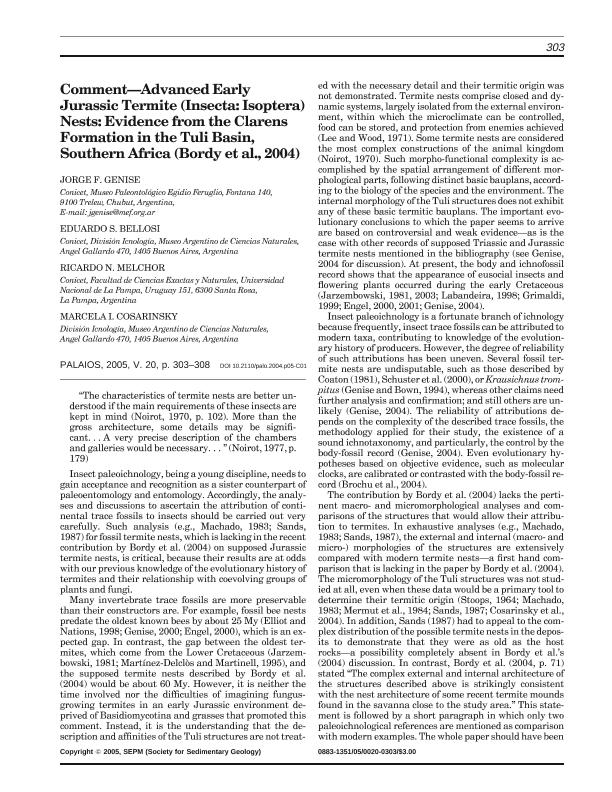Mostrar el registro sencillo del ítem
dc.contributor.author
Genise, Jorge Fernando

dc.contributor.author
Bellosi, Eduardo Sergio

dc.contributor.author
Melchor, Ricardo Nestor

dc.contributor.author
Cosarinsky, Marcela Irene

dc.date.available
2020-05-06T14:58:52Z
dc.date.issued
2005-12
dc.identifier.citation
Genise, Jorge Fernando; Bellosi, Eduardo Sergio; Melchor, Ricardo Nestor; Cosarinsky, Marcela Irene; Comment-Advanced Early Jurassic Termite (Insecta:Isoptera) Nests: Evidence from the Clarens Formation in the Tuli Basin, Southern Africa (Bordy et al., 2004); Society for Sedimentary Geology; Palaios; 20; 3; 12-2005; 303-308
dc.identifier.issn
0883-1351
dc.identifier.uri
http://hdl.handle.net/11336/104324
dc.description.abstract
The contribution by Bordy et al. (2004) lacks the pertinent macro and micromorphological analyses and comparisons with modern nests that would allow their attribution to termites. It also lacks any analysis about the age of the structures in comparison with the bearing rocks. In addition, the described features are not indicative of termitic origin, as summarized below: (a) Eolian dunes as those described from the Clarens Formation, are inhabited only by few termites that construct no mounds, but completely subterranean nests. In addition, this environment is poorly vegetated or lacks any vegetation at all, which would not support large colonies of termites; (b) The features and size of the interconnecting bioturbated cylinders are not compatible with any known termite gallery; (c) The orientation of the structures is not diagnostic of termite nests, even less, when pillars, ?buttresses? and ?bioturbated cylinders? show the same orientation; (d) The purported buttresses are almost unknown for termite nests and show a close resemblance to structural joints; (e) Type 1 burrows lack a detailed description and interpretation. For this reason, it is impossible to attribute them to social or solitary organisms, even less to termites when branching is rare; (f) The attribution of type 2 burrows to ants is unsupported. Besides, this aspect is not critical to the identification of termite nests; (g) Type 3 burrows display characteristics that occur in a wide array of sedimentary deposits and are not diagnostic of termite nests; (h) The wall of the purported termite nests is an order of magnitude thinner than the same structure in modern termite nests; (i) The absence of clay in the structures is contradictory with the inferred fungus-growing termites, because the clay content of soil is critical for the construction of these subaerial nests; (j) The presence of advanced fungus-growing termites as purported producers of the Tuli structures is unlikely by the early Jurassic, considering that the oldest termites come from the Cretaceous, and there is no record of grasslands and gilled fungus until the Tertiary.In consequence, it is considered that the interpretation of the Tuli structures as termite nests is unsubstantiated and should be revised.
dc.format
application/pdf
dc.language.iso
eng
dc.publisher
Society for Sedimentary Geology

dc.rights
info:eu-repo/semantics/openAccess
dc.rights.uri
https://creativecommons.org/licenses/by-nc-sa/2.5/ar/
dc.subject
COMMENT
dc.subject
JURASSIC
dc.subject
TERMITE NESTS
dc.subject.classification
Paleontología

dc.subject.classification
Ciencias de la Tierra y relacionadas con el Medio Ambiente

dc.subject.classification
CIENCIAS NATURALES Y EXACTAS

dc.title
Comment-Advanced Early Jurassic Termite (Insecta:Isoptera) Nests: Evidence from the Clarens Formation in the Tuli Basin, Southern Africa (Bordy et al., 2004)
dc.type
info:eu-repo/semantics/article
dc.type
info:ar-repo/semantics/artículo
dc.type
info:eu-repo/semantics/publishedVersion
dc.date.updated
2020-04-22T15:38:39Z
dc.identifier.eissn
1938-5323
dc.journal.volume
20
dc.journal.number
3
dc.journal.pagination
303-308
dc.journal.pais
Estados Unidos

dc.journal.ciudad
Kansas
dc.description.fil
Fil: Genise, Jorge Fernando. Museo Paleontológico Egidio Feruglio; Argentina
dc.description.fil
Fil: Bellosi, Eduardo Sergio. Consejo Nacional de Investigaciones Científicas y Técnicas. Oficina de Coordinación Administrativa Parque Centenario. Museo Argentino de Ciencias Naturales "Bernardino Rivadavia"; Argentina
dc.description.fil
Fil: Melchor, Ricardo Nestor. Universidad Nacional de La Pampa. Facultad de Ciencias Exactas y Naturales; Argentina
dc.description.fil
Fil: Cosarinsky, Marcela Irene. Consejo Nacional de Investigaciones Científicas y Técnicas. Oficina de Coordinación Administrativa Parque Centenario. Museo Argentino de Ciencias Naturales "Bernardino Rivadavia"; Argentina
dc.journal.title
Palaios

dc.relation.alternativeid
info:eu-repo/semantics/altIdentifier/url/https://bioone.org/journals/palaios/volume-20/issue-3/palo.2004.p05-C01/CommentAdvanced-Early-Jurassic-Termite-Insecta--Isoptera-Nests--Evidence/10.2110/palo.2004.p05-C01.short
dc.relation.alternativeid
info:eu-repo/semantics/altIdentifier/doi/https://doi.org/10.2110/palo.2004.p05-C01
Archivos asociados
